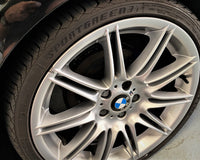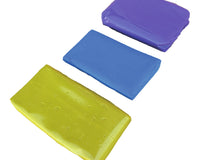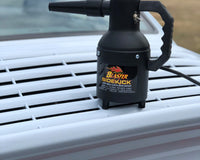When it comes to detailing a car's interior, most enthusiasts focus on the seats, dashboard, and carpets. However, the headliner, a fabric-covered material lining the ceiling of your car is often overlooked. Despite its inconspicuous position, the headliner plays a critical role in the car’s aesthetic appeal, acoustic dampening, and insulation. Over time, it can accumulate dust, smoke residue, handprints, pet hair, and even mould, especially in high-humidity environments. Cleaning it, though, is not as simple as wiping it down because headliners are delicate and improperly cleaning them can cause sagging, permanent stains, or fabric separation.
This ultimate guide will walk you through everything you need to know about safely cleaning car headliners, from understanding the materials to selecting the right tools and products. By the end, you'll know how to maintain that fresh, factory-clean look overhead without causing damage.
Understanding What a Car Headliner Is
What Is a Headliner Made Of?
A typical car headliner is composed of three layers: a backing board made of fibreglass or compressed foam, a thin layer of polyurethane foam, and the outermost fabric layer which can be cloth, suede, or even vinyl. These layers are bonded together with a spray adhesive, which is particularly vulnerable to heat, moisture, and harsh chemicals.
Because of this composition, the headliner is not built to handle excessive agitation or saturation. Over-wetting or scrubbing too hard can cause the adhesive to fail, resulting in sagging or delamination. This is why cleaning a headliner is more about gentle maintenance than deep scrubbing.
Common Causes of Headliner Contamination
Headliners can become dirty or stained due to a number of reasons. Smoke residue from cigarettes or vapes, food spills, air pollution, insects, hair oil, and dampness are common culprits. In addition, children touching the ceiling or loading dirty objects into the car can leave marks. If the car is stored in a humid garage or driven in rainy climates, mildew and mould can also take hold, which not only looks unpleasant but also affects air quality and odour inside the car.
Knowing the source of the contamination helps you determine the best cleaning strategy. Light dust requires only a dry clean, while smoke or mould needs a more intensive, but still careful, approach.

Tools and Products You’ll Need
Safe Products for Headliner Cleaning
Selecting the right products is crucial. Unlike leather or vinyl surfaces, headliners don’t respond well to aggressive chemicals or high-pH cleaners. Opt for fabric-specific cleaners designed for delicate upholstery, or choose an all-purpose cleaner (APC) that is explicitly safe for use on headliners.
Microfibre towels are ideal for application and blotting, while a soft-bristle interior detailing brush will help dislodge dirt without damaging the fibres. For spot-cleaning, foam upholstery cleaners or enzyme-based sprays are effective, especially on organic stains like food or drink.
Tools Checklist
-
Soft-bristle detailing brush
-
Lint-free microfibre cloths (at least 2–3)
-
Upholstery or fabric cleaner (headliner safe)
-
Spray bottle with water (for dilution or rinse)
-
Interior vacuum with a brush attachment
-
Optional: steam cleaner with a soft nozzle for advanced users
Avoid using hard brushes, vigorous scrubbing pads, or harsh degreasers. If in doubt, always test a small inconspicuous area first.
Step-by-Step Guide to Cleaning a Car Headliner Safely
Step 1: Initial Dust and Debris Removal
-
Begin by inspecting the headliner in natural light to identify problem areas.
-
Use a vacuum cleaner with a soft brush attachment to gently remove loose dust, pet hair, and surface debris.
-
Move the vacuum in straight, overlapping lines to avoid pressing into the fabric too hard.
-
Avoid circular motions which may lift or twist the fabric weave.
This dry clean will already improve the look and prevent dirt from smearing during wet cleaning.
Step 2: Light Surface Cleaning
-
Lightly spray your chosen headliner-safe cleaner onto a microfibre cloth — never directly onto the fabric.
-
Gently dab the affected areas. Do not rub or scrub, as this can dislodge the foam backing.
-
For broader areas, fold the cloth and use a patting or light sweeping motion.
-
If a stain is present, allow the cleaner to sit for 30–60 seconds before dabbing again.
Repeat this process in small sections until the whole surface is clean or until you've treated the targeted spots.
Step 3: Spot Cleaning Tough Stains
-
Apply a foam upholstery cleaner or enzyme-based stain remover to the stained area by spraying it on a cloth first.
-
Use a soft-bristle brush in a circular blotting motion, not scrubbing, to lift the stain.
-
Blot with a clean dry towel to remove residue and moisture.
-
For oily stains like fingerprints or hair grease, a diluted vinegar solution (1:4 vinegar to water) can help — but always patch-test.
Allow the fabric to dry completely between spot treatments to prevent saturation.
Step 4: Steam Cleaning (Advanced)
-
This step is only recommended for experienced users or professionals.
-
Use a low-moisture steam cleaner with a soft brush head to gently steam one section at a time.
-
Hold the steam nozzle a few inches away to avoid soaking the fabric.
-
Use a clean microfibre towel to immediately blot up any moisture.
Steam helps lift embedded dirt without chemicals, but if misused, it can weaken the glue and cause sagging. Only use if necessary and with care.
Step 5: Odour and Mould Control
-
If there is a persistent odour or mould issue, treat the headliner with a dedicated enzyme spray or anti-microbial upholstery spray.
-
Allow it to sit as per product instructions, then blot with a dry towel.
-
Air out the car with windows open or run the AC system with the car on for at least 30 minutes.
For severe mould infestations, professional ozone treatment may be required to completely neutralise the spores.
How Often Should You Clean Your Headliner?
Preventative Maintenance
Unlike seats or floor mats, your headliner does not need frequent cleaning. A light vacuum every 1–2 months is sufficient to keep dust and lint at bay. Spot clean as soon as spills or stains occur to avoid them setting in.
If your car is a smoker’s vehicle or often carries children or pets, consider cleaning every 3–4 months with a gentle hand to maintain a fresh interior.
Seasonal Deep Cleaning
Performing a more thorough clean once or twice a year — particularly before summer and winter — ensures grime doesn’t build up and damage the adhesive over time. Seasonal checks also allow you to monitor any sagging or fabric fatigue, which may eventually require professional repair.
Pro Tips for Maintaining a Pristine Headliner
Avoid Direct Contact
Encourage passengers, especially children, not to touch the ceiling. Oils and residue from hands can discolour the fabric and weaken the bond.
Control Moisture
Use dehumidifier bags or silica gel packs inside the car during damp seasons. If your car has a sunroof, ensure its drainage system isn’t blocked — clogged sunroof drains are a major cause of headliner moisture damage.
Regular Interior Detailing
Include the headliner in your regular detailing routine — not by deep-cleaning it every time, but by inspecting it and doing light touch-ups. This proactive approach reduces the need for aggressive interventions later.
When to Call a Professional
There are cases where DIY efforts just won’t cut it. If the headliner has widespread mould, persistent smoke odour, or visible sagging, you’re better off calling a professional detailer or upholstery specialist. Attempting to salvage a deteriorated headliner on your own could make it worse and lead to more expensive repairs.
Professional detailing may also be the safer route if your vehicle has a suede or Alcantara headliner, as these materials require specialised care and unique products.
Conclusion
Cleaning your car’s headliner may not be the most glamorous task in the detailing world, but it plays a vital role in preserving the look, smell, and integrity of your vehicle's interior. Given how delicate the material and construction can be, a gentle, methodical approach is essential. Whether you're dealing with light dust, isolated stains, or lingering odours, the right tools and techniques can go a long way toward restoring your headliner to like-new condition.
By understanding the fabric, choosing the right products, and practising safe cleaning methods, you can maintain a spotless and structurally sound headliner for years to come. And remember — when in doubt, less is more. A little care today saves a big repair tomorrow.




